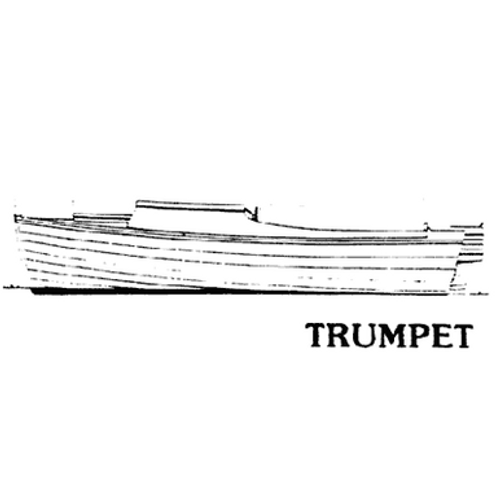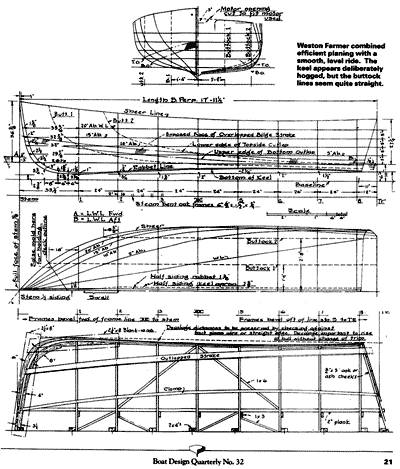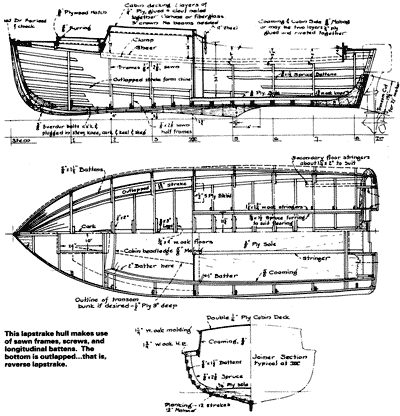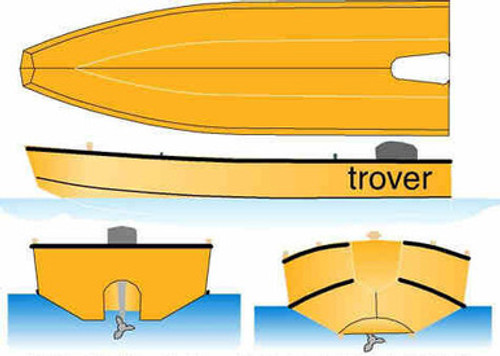"TRUMPET" - 18' Rough water clinker-built runabout, wood. This is a modified v-bottom outboard powered "pocket cruiser", with cuddy cabin and bunks forward. 6' 6" beam. Includes 1958 original article run in Sports Afield's Boatbuilding Annual, lines, table of offsets, construction plans, inboard and outboard profiles, and other details.
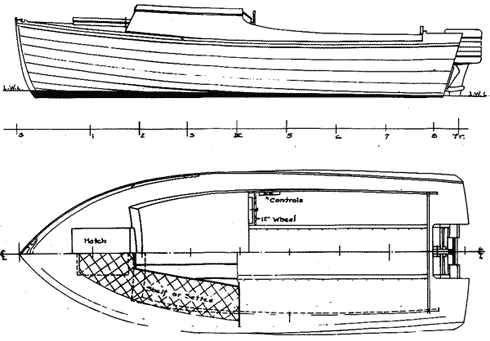
Here we have a handsome, and deceptively innovative, outboard runabout/cruiser from Weston Farmer's drawing table. Trumpet will make fine use of a quiet, efficient, and expensive four-stroke outboard motor.
As the designer introduced this boat in From My Old Boatshop (International Marine, 1979; Boat House, 1996), his enthusiasm seemed more than evident: "...Trumpet was long in the cooking, or gestational period, and highly successful in execution. She is the keystone piece in my ganglia of narrative design hooks, which I dangle overside in our voyage through this book, trolling in the usual voyaging pastime of fishing for nourishment for the fun of it."
"What I wanted (on my way to the drawing board) was a soft-riding, full-hydroplaning runabout that wouldn't change trim from zero speed to full-bore work.... The early boats of [many] designers all stood on their tails, running with their bows to the sky and their stems depressed and nearly awash.. .the bows planed, the sterns did not. But step hydroplanes, with one step in their hulls, would jump out of water, level down, and go like blazes."
Motivated by intellectual curiosity and monetary considerations, Farmer set out to learn “why narrow monoplane hulls would not flatten down and run level.” At a time when this type of boat reportedly outsold others by ten to one, he reckoned it wise to “go with the money.”
A modicum of early success came when he studied the work of Bruno Beckhard. The Long Island experimenter had built an 8’ sled-type hydroplane that ran faster than conventional runabouts fitted with much more powerful engines. Here are Beckhard’s “secrets” as deciphered by Farmer: “[Drawing] proper beam [more than was normal at the time], putting power far aft [hence the transom-mounted outboard motor], limiting deadrise to 5 degrees....”
Armed with these thoughts, Farmer drew a series of runabouts that ran level at speed.. .but the soft ride still eluded him. Then, one day, “it all came together” for the prolific writer: “Why not meld a hull running at normal attitude into the profile of a boat with level running forefoot?” This insight led to the hull lines you see here.
Trumpet’s keel appears to be deliberately hogged. Farmer argues that this helps produce “inherent fore-and-aft trim components,” which result in a boat that lifts at speed but never aims her nose at the sky. He points out that the bottom is not hooked. Indeed, the buttock lines back aft do appear quite straight.
Does all of this rumination really produce an efficient, smooth-running hull? Farmer certainly seemed to think so, and every photo I’ve seen shows Trumpet running level and looking fine. Other fellows, while not denying Trumpet her virtues, hold that the same performance might be attained by easier-to-build conventional hulls fitted with adjustable trim tabs,. .perhaps a simpler, if less elegant, solution.
At first glance, Trumpet’s hull appears to be built in conventional lapstrake (clinker) fashion. It is not. The bent frames and copper rivets that I recall from my youth at the Jersey shore in the mid - 1900s have been replaced by sawn frames and screws. Longitudinal spruce battens, which back all plank laps, are notched into each frame. The results will prove strong and the process tedious.
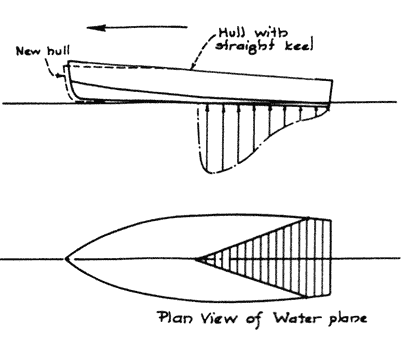 Trumpet's desiger compared a normal planing hull (above) to a "decalage" hull (below): "Because of its deepened forefoot, the latter gains lifting surface forward, softening the way for the planing surface aft." 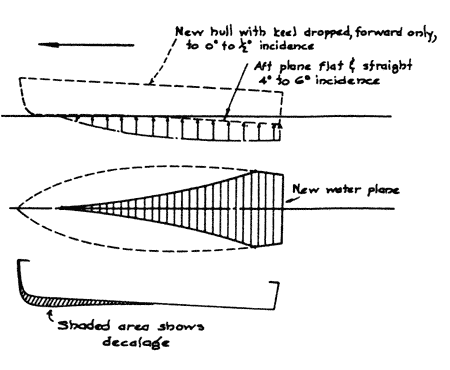 |
The construction sections reveal that the boat’s bottom, from the turn of the bilge to the keel, is outlapped (reverse lapstraked). Farmer saw this as a way of providing “peeler strips”—longitudinal steps or ventilators—for the out-flying water. Although not everyone would agree in detail, he considered their function identical to that of the strakes that Ray Hunt employed on his deep-V hulls at about the same time. Citing work done by George Crouch twenty years earlier, Farmer took no credit for the idea.
Trumpet’s designer seemed quite pleased with the fruits of his experimentation: “. . . a slick hull of excellent seakeeping qualities that has proven a delight to the eye, a treasure to own, and is envied by all who have seen her.”
Will the outlapped bottom prove superior in performance to those of traditional clinker construction? The two outlapped boats I knew at the Jersey shore during the l9SOs were so different of line from their neighbors that we could learn little from them. They went well enough, but both suffered structural failure at the turn of the bilge (a problem that ought not plague the robust Trumpet). To answer questions of performance, we’ll need to identify and isolate the variables. Let’s build two boats to Farmer’s good drawings. We’ll make them as identical as can be.. .save that one will be of traditional Iapstrake construction and the other will have the outlapped bottom. A noble experiment!
Bruno Beckhard’s sled-type hydroplane provided early inspiration in Farmer’s search for a hull that would run level, smooth, and fast.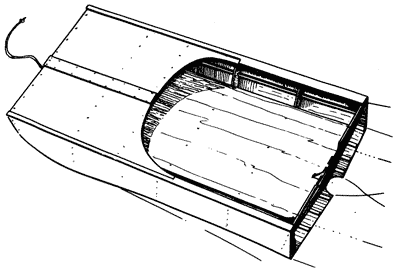 |
There seems little doubt that this skiff will blast smoothly into a moderate chop. But, when running off, we will worry that her deep forefoot might dig into the steep green backs of the breakers as we scoot in through Bamegat Inlet, Will she want to root and otherwise misbehave? Her hull quickly picks up buoyancy above the waterline forward, which will ease our minds. Sixty years spent at the waterfront, and twenty in physics laboratories, have convinced me that solving numerical equations won’t help much here. Perhaps we can get hold of a Trumpet and head down the coast from Manasquan to Bamegat fresh on the heels of a moderate nor’easter.. .while the sea is still running. That trip will tell us what we need to know.
—M.O’B.
TRUMPET
An 18' runabout/cruiser
Particulars:
LOA - 18"
Beam - 6'6"
Draft 10"
Weight (w/motor) - 1635 lbs.

